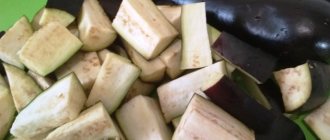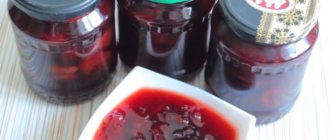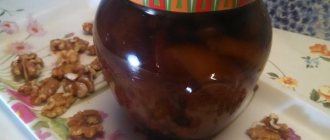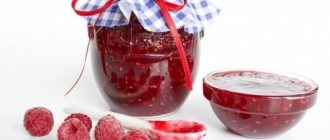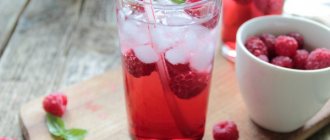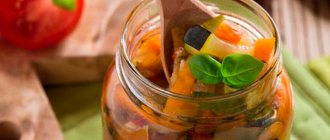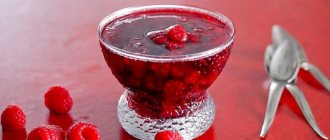≡ Home → Lingonberries → About lingonberries →
The lingonberry harvest season is very short, but if certain rules are followed, it can be stored all winter and even longer. There are many methods for harvesting and storing fruits, and each of them has its own characteristics.
Lingonberries soaked in water and jam made from them are options for preserving berries, each with its own distinctive characteristics.
When freezing, soaking or drying, the integrity of lingonberry berries and all their vitamins are preserved. During the canning process, the berries become wrinkled and lose some of their properties due to heat treatment, but in this state they can be kept on the shelf for several years. At the same time, soaked berries are stored only in a cold place for 2-3 months, and frozen ones - in the freezer for about a year.
Fresh lingonberries and cranberries at a market in Finland.
You need to choose a method for harvesting lingonberries depending on how they will be used in the future and how long they need to be preserved.
Different ways to store lingonberries
Lingonberries contain a lot of benzoic acid, thanks to which it does not turn sour and mold for a long time. If you need to store fresh lingonberries for a week or a month, you can simply put them in the refrigerator. Plastic containers can be used as containers. To prevent the berries from getting bruised, they are laid out in one layer, separated by paper towels. When choosing this storage method, you need to regularly inspect the berries, checking for spoilage fruits and remove them in a timely manner.
From left to right, top to bottom: lingonberries in sugar syrup, lingonberries in water, lingonberry jam
To preserve lingonberries for a longer time, you can:
- Freeze in bulk at low temperature;
- Freeze with sugar or in the form of briquettes;
- Dry in the oven or naturally;
- Preserve in the form of juice, fruit drink, compote, preserves or jam;
- Grind with sugar without heat treatment;
- Pour in water or sweet syrup;
- Soak in your own juice.
Dried berries can be stored without refrigeration in glass jars or cloth bags in cool and dry places. It is advisable to keep fruits soaked in water, syrup or their own juice at a temperature of +3-5 °C. At home, a shelf in the refrigerator is suitable for storage, and in winter, a place on the balcony.
Methods for preparing lingonberries for the winter to preserve vitamins
Fresh lingonberries
To store fresh berries you will need a cardboard box. You need to carefully place intact berries into it. Place the box in a cool place, for example on a balcony. But provided that the place where the berry stands is not exposed to direct sunlight. Also, a refrigerator or a dug cellar is ideal for storage.
If severe cold begins, immediately remove the berries from the balcony. It will freeze, which means it will be unsuitable for food. You can store berries this way in a cardboard box for up to 2 months. The main thing is that preliminary preparation has been carried out, namely washing and drying the berries.
If there is a need to leave lingonberries for a longer period , for this they need to be cooked in their own juice . To do this, the berries are thoroughly washed and sorted. Then, take a sterilized jar and place the berries on the bottom in one layer of 3 to 5 cm. Then, gently crush the berries with a wooden spoon until it yields juice.
After this, another layer is laid out again and the same procedure is carried out. This is repeated until the entire jar is filled. Then you need to close the container with a lid and put it in the refrigerator.
During the first month, check the jar for mold growth. In this form, the berry can be kept in a cool place for up to 7 months, and it will not lose its taste and healing properties.
Frozen lingonberries
And of course, the berries can be frozen. To do this, the lingonberries need to be carefully laid out on a tray and placed in the freezer. As soon as the berries become hard, they are placed in a container or in a special bag for freezing. Place neatly in the freezer. You can store berries this way for 1 to 3 years. However, remember that during the defrosting process, the berries will definitely lose about 30% of their beneficial properties.
This method is considered more gentle than cooking, since the berries do not undergo heat treatment. Lingonberries should only be frozen in a dry state. But there is one important detail: defrosting. After this, it is not recommended to freeze lingonberries again.
Pickled lingonberries
In this case, again, due to the lack of heat treatment, wild berries do not lose their vitamins and are wonderfully preserved even for the winter. To prevent the product from spoiling, you should add either granulated sugar or salt to it and marinate.
Soaking lingonberries
This method is absolutely not dangerous for the beneficial qualities of lingonberries. The berries can simply be poured or crushed without adding sugar.
What's the best way to store berries?
The berries are not subjected to any preliminary heat treatment
Each storage method has its own advantages and disadvantages and is suitable for different purposes. The simplest method is to soak lingonberries in water or sugar syrup. The fruits are placed in a container, filled with cold water and left. This way they stay fresh for about 2-3 months, but only at low temperatures.
The freezing method, subject to the correct technology, also allows you to keep freshly picked berries intact and, after defrosting, get almost fresh fruits. However, if you do not freeze at a low enough temperature or leave the berries slightly damp, they may stick together. The same will happen if the workpiece defrosts even a little. By the way, the appearance of the berries also depends on how they are defrosted before use. You can store lingonberries in the freezer for several years, but it is still advisable to use them before a new harvest appears, since it is believed that after a year its benefits decrease.
Another way to store fruits for a long time is drying. It is suitable in cases where lingonberries are planned to be used, for example, for preparing compotes or adding to tea, or eating them dried without culinary preparation. The properties of lingonberries are preserved when dried.
You can also ensure long-term storage of berries by canning them. In this form, lingonberries can be placed on shelves in the pantry or kitchen and used for 1-3 years. It should be taken into account that during the preservation process, fruits are subject to heat treatment.
If you want to avoid cooking, you can grind the lingonberries in a blender along with sugar. This jam can be stored in the refrigerator for a couple of months. You can also crush the berries and leave them in their own juice for storage.
Rules for freezing lingonberries
Lingonberries need to be properly prepared for freezing. It must be sorted, leaving only ripe berries and removing green or overripe fruits, leaves and other small debris. After this, they should be rinsed in a colander or container of water. It is better to wash lingonberries in small portions, and when using a colander, turn on low water pressure so that the berries do not accidentally get bruised.
Dirty berries may spoil when frozen.
Washed lingonberries must be completely dried. To do this, it must be laid out in one layer on large dishes or trays. To speed up this process a little, you can spread paper towels under and on top of the berries to absorb excess moisture. It is not advisable to freeze wet fruits, as they will stick together and look depressed after defrosting.
In industrial enterprises, fruits and vegetables are frozen at very low temperatures - from -60 ° C and below. Thanks to this, they freeze very quickly and do not have time to stick together. Also, when quickly frozen, large ice crystals do not have time to form in the juice, so the shell of the fruit remains intact. Some freezers have a “Quick Freeze” function that creates similar conditions.
When freezing lingonberries at home, it is best to divide them into small portions. To prevent the fruits from sticking together, they can be placed on dishes and placed in the freezer. After the first batch is frozen, you can pour it into a bag or container and put the next one in the freezer.
Actually, frozen lingonberries are stored in bags.
To freeze all the berries at once, they can be packaged in special slider bags designed for freezing vegetables and fruits, or in regular bags with an adhesive valve. In them, the berries are carefully placed in one layer, then excess air is removed from the bags and closed. These bags can be stacked one on one in the freezer.
It is also useful to read: Lingonberry tea and its benefits for the body
You can store berries in the freezer for several years. At the same time, it is necessary to ensure that they do not defrost. If this happens, the fruits will release juice and stick together.
On a note
How aesthetically pleasing the berries will look after freezing also depends on how they are thawed. It is best to remove the berries from the freezer 5-8 hours before use and refrigerate. There they will gradually thaw, preserving as much as possible their original appearance and all useful properties. If you can’t wait that long, you can leave the lingonberries to defrost at room temperature. In this case, it will become usable in an hour or more depending on the quantity. The fastest way to defrost the berries is in the microwave, but in this case they will release juice and lose some of their beneficial properties.
How to quickly sort through the harvest
Having harvested a large harvest, it is worth asking the question: how to clean the fruits from so much debris? In this case, there are several effective ways to clean raw materials. Which one to choose depends on the degree and type of contamination of the harvested crop.
Cleaning on rough surfaces
To clean the harvested crop from debris, it is necessary to make an inclined chute. Cover the bottom of the device with a rough cloth, and roll the berries down the gutter in small portions. During the cleaning process, debris will remain on the surface of the fabric, and the fruit will begin to roll into the basin.
Sifting in the wind
This cleaning method is suitable in windy weather. A wide basin needs to be placed on the ground, a small container with the harvested crop should be raised up one and a half meters. Start pouring out the fruits in small portions. The wind will blow away the debris, and the clean berries will fall into the prepared container.
Using a vacuum cleaner
Dry berries can be quickly removed from debris using a vacuum cleaner. Place a small amount of fruit in a sieve and direct air flow from below. To do this, the vacuum cleaner hose is connected to the blower.
Using a wide mesh
When picking lingonberries in the forest, not only twigs and small leaves, but also sand and soil particles end up in the container with the berries. You can get rid of such pollution using a wide mesh. It needs to be installed at an angle, a film should be spread underneath or a large container should be placed and the fruits should be slowly poured out.
See also
When and how to properly pick lingonberries with your own hands, equipment
Read
How to properly soak lingonberries
Lingonberries can be soaked in water, sugar or honey syrup. This will keep it fresh for several months. Previously, small wooden barrels were used for soaking, which were stored in cellars. In urban environments, you can use glass jars or plastic containers.
Lingonberries float to the surface in water, so you can pour them into the jar at the very top and pour enough water so that it comes to the edge of the neck.
As with freezing, the berries must first be sorted, washed and dried. The containers also need to be washed well. The prepared fruits need to be placed in containers, filling them halfway or a little less. Water for pouring should be boiled and pre-cooled.
If desired, you can add sugar or honey to the water and prepare syrup. For 3 liters of water take 500-700 grams of sugar or half a liter of honey. They are added to hot water and stirred until completely dissolved. You can pour syrup over the berries only after it has cooled to at least room temperature.
It is advisable to store soaked lingonberries at a temperature of +3-5 °C. It can be placed in the refrigerator, on the balcony or in the closet in the apartment. The main thing is that the drenched lingonberries do not stand in the sun and are not heated by any heat sources. At low temperatures it can be stored for up to 3 months.
Storing berries in their own juice
Lingonberries in their own juice are prepared as follows:
- Pre-prepared berries are placed in washed or sterilized jars with a wide neck, filling them no more than a third;
- Then the berries are crushed with a wooden pestle or spoon so that they release the juice and are covered a little with it;
- After this, several layers of gauze or other clean cloth are placed on the berries, and a board with a weight is placed on it;
- The next day, when the fruits give more juice and settle, the weight and fabric are removed from them and a new portion of berries is added, which is crushed like the first;
- In this way, the entire jar is gradually filled with lingonberries, after which it is closed with a lid and put in a cool place.
Lingonberries in their own juice should be stored in the refrigerator. At low temperatures it can last until spring.
Recipes for canning lingonberries
During the canning process, the berries are heat treated and pasteurized, and the containers are sterilized and hermetically sealed. Thanks to this, the fruits can be stored at room temperature for several years.
To preserve lingonberries, you can make a fruit drink, make jam, or make jam. If desired, the berries can be left untouched and preserved in their natural form.
Lingonberry jam is an almost homogeneous mass obtained from berries twisted with sugar.
For canning, it is very important to properly prepare the container. Glass jars and lids must first be washed well and then sterilized. This can be done in several ways: in a pan of water by boiling, steaming, in the oven and even in the microwave.
Small jars are easiest to sterilize in a saucepan. They must be carefully placed on the bottom and filled to the top with water. You can place metal lids nearby. Over medium heat, bring the water to a boil, then reduce the heat slightly and leave the container to sterilize for 10-30 minutes, depending on its volume. Liter jars are sterilized for 10 minutes, and three-liter jars, respectively, for 30 minutes.
Jars can also be sterilized by steam. To do this, place a special stand with recesses for cans or a grill on a large pan of water. The jars are placed with the neck down and after the water boils, they are left to sterilize for 10-30 minutes.
Such sterilization significantly reduces the risk of “bloating” of the jars.
The oven can sterilize many jars of different sizes at one time. To do this, you need to wash them and place them in the oven, wet, on a baking sheet or wire rack, neck down. The oven should be turned on only after all the containers have been assembled and heated to 150 °C. The jars are sterilized in this way for about half an hour. Metal lids can also be sterilized in the oven, but only if they do not have rubber inserts.
It is also useful to read: The benefits and harms of lingonberry berries and leaves
Regardless of the sterilization method, the jars become very hot during the process, so they should only be handled with a towel or a special glove.
Features of preparing soaked lingonberries
They prepare it for future use in different ways, but, as practice has shown, it is the soaked one that lasts much better and longer.
To do this, it is important to carry out the process correctly
Urination has the following features:
- A large number of berries for preservation in this way are placed in large containers made of plastic or wood.
- Before placing lingonberries in a container, the berries undergo careful selection.
- If you come across leaves during the preparation process, do not throw them away. By transferring lingonberries with them, we get an additional portion of vitamins and microelements in the marinade.
- Antonov apples will give a pleasant aroma to the forest gift. They are cut into large cubes and placed on top.
- Soaked lingonberries without sugar and spices will last for a long time. The fruits contain benzoic acid, which is responsible for preservation, but the filling must be changed periodically. Without sugar, it can become moldy or sour.
Important! Lingonberries are very useful in any form. Regular consumption will improve metabolic processes, strengthen the heart and blood vessels, and in winter it will be an excellent immunomodulatory agent.
Recipe for preserving lingonberries in their natural form
Lingonberries can be preserved in their natural form by simply adding hot water. To do this, jars and lids should be sterilized, and the berries should be sorted and washed. Then the raw fruits need to be placed in jars, filled halfway, filled with hot water and pasteurized.
Pasteurize the workpieces in a pan of boiling water or in the oven. In the first case, the jars need to be placed in boiling water and kept there for 10 to 25 minutes. The jars can be covered with temporary lids to prevent water or anything else from getting into them. When pasteurizing in the oven, the jars are placed open on a baking sheet and heated at a temperature of 120°C.
After pasteurization, the jars should be carefully removed from the water or from the oven, tightly screwed on with lids and, turning the neck down, left to cool. When the jars have cooled, they can be transferred to a permanent storage location.
On a note
When canning, it is very important to properly sterilize the container, prepare the berries themselves and pasteurize the product. If the jars are poorly sterilized or contain spoiled fruits, the products may deteriorate and swell. The same can happen when the lids of the jars are not properly screwed on, when they are not airtight, or when the blanks are stored in a too warm place.
Lingonberry juice with sugar
Before starting cooking, extract juice from the berries. This can be done manually, using a juicer or juicer. A simple way is to grind the berries in a blender and squeeze through a cloth bag. Another method is described in the recipe for lingonberry juice with sugar.
What ingredients to take:
- lingonberry juice – 1.2 l;
- sugar – 600 g.
Preparation progress:
- Cover the lingonberries with water in a saucepan. You will need about a glass of water. Push until the berries burst. Bring to a boil.
- Let it brew for 2-3 hours. Place on an iron sieve and cheesecloth. All liquid should drain.
- Add sugar to the liquid.
- Boil for 10 minutes.
- Pour into sterilized jars.
- Sterilize in a saucepan of gently boiling water for 25 minutes (500 ml jars). For liter jars the time increases to 35 minutes, for 3 liter jars up to 45 minutes.
- Seal tightly with lids.
Lingonberry jam recipe
Jam differs from jam in that it can contain whole berries that are not crushed before cooking.
To make jam, for one kilogram of berries, take one and a half kilograms of sugar and half a liter or a little more water.
Prepare jam as follows:
- The berries are sorted, leaving only ripe fruits, washed and dried;
- Then they are put in a colander and poured with boiling water to remove the bitterness, and placed in an enamel pan or bowl;
- The syrup for jam is prepared separately. Sugar is added to boiling water and stirred until it is completely dissolved;
- After this, the berries are poured with the prepared syrup, mixed well and placed on low heat;
- Boil lingonberry jam for 30 minutes;
- Then it is laid out in sterile jars, pasteurized and sealed with airtight lids.
- The jam is left to cool in the jars without turning them over.
The finished jam can be stored for several years in suitable conditions.
There are a lot of recipes for processing and preserving lingonberries. It is often topped with cranberries or apples, the latter adding greater sweetness to the preparation.
Description of preparation:
It’s not for nothing that lingonberries are usually called the berry of health, because they contain vitamins A and B, vitamins C and E, as well as other useful microelements. But personally, I adore this berry not only for its benefits, but also for its excellent taste with sourness, so I always try to make as many preparations from it as possible. You can make compote, preserves, jam and many other goodies from lingonberries, but today I want to tell you how to prepare soaked lingonberries for the winter. This is a fairly simple recipe and you won’t spend a lot of time on it, but in winter you will be happy to open a jar of such tasty, aromatic and healthy lingonberries, which, by the way, can even be added to meat as a sauce. So let's take care of our health and prepare delicious soaked lingonberries for the winter. 1) First, we thoroughly rinse the jars and scald them with boiling water. 2) We sort out the lingonberries (you can leave the leaves, they are also very useful), and wash them. 3) Place the berries in the jars so that they almost completely occupy the space of the jar. 4) Pour water into a saucepan and put it on fire, add water, salt, sugar, pepper, cloves and cinnamon. As soon as the liquid boils, remove it from the heat, strain and let cool. 5) When the syrup has cooled completely, pour it over the lingonberries and cover with a lid. Now you know how to prepare soaked lingonberries for the winter, so as soon as the berry ripening season begins, be sure to use this simple recipe. And such lingonberries can be stored throughout the winter in a cool place. Purpose: For breakfast / For lunch / For dinner / For children Main ingredient: Berries / Lingonberries Dish: Preparations
How to properly dry lingonberries
You can prepare lingonberries for the winter by drying them in the oven or in natural conditions. First you need to sort it out, removing green fruits and small debris, and then wash it.
To dry in the oven, lay the lingonberries in one layer on a parchment-lined baking sheet. Dry the berries at a temperature of about 60 °C for 2-3 hours or more. You need to focus not on time, but on the degree of readiness of the fruit. It is advisable not to close the oven tightly, leaving a small gap so that the berries inside do not dry out. The condition of the fruits should be checked frequently and mixed if necessary.
Under natural conditions, lingonberries are dried in a ventilated room in the shade. It is laid out on large dishes or trays and left for several days. Moreover, if there are a lot of lingonberries and they are poured in several layers, they need to be mixed 1 or 2 times a day. During drying, you need to make sure that the berries do not begin to deteriorate anywhere.
Completely dried lingonberries should be placed in glass containers with lids or special bags made of thick fabric. It should be stored in a cool place out of direct sunlight.
These berries retain the maximum amount of nutrients.
Benefits for humans
Lingonberry has been used as a valuable medicinal plant for several centuries. This is due to the presence of a large number of useful substances in it.
Perennial evergreen shrub contains:
- potassium, calcium, iron, phosphorus, magnesium, copper;
- provitamin A;
- acids of organic origin;
- mineral salts;
- pectins;
- vitamin B2;
- Sahara.
Tannins cleanse the body of heavy metals (lead, cesium, cobalt).
The anti-inflammatory properties of the plant enhance the effect of medicines, so the berries are taken for fever (the juice can reduce body temperature) and as a restorative remedy after serious illnesses.
The perennial evergreen shrub is used to treat the following diseases:
- prostatitis;
- pyelonephritis;
- bronchitis;
- pneumonia;
- rheumatism;
- cystitis;
- gingivitis;
- stomatitis;
- tonsillitis;
- angina;
- mastitis;
- lichen;
- scabies;
- diabetes;
- oncology.
Berry juice, infusion of leaves and fruits, juice, jam have a healing effect, so it is important to preserve lingonberries so that they do not lose their beneficial properties
Other storage methods
This juice stores a large amount of vitamins
In the process of harvesting lingonberries, there is always some bruised fruit that cannot be frozen or soaked in water along with others. Such berries can be stored for the winter in a different form. You can squeeze juice out of them, which can be stored in a bottle in the refrigerator for about two weeks, and if preserved - for more than a year.
You can also grind crushed fruits together with sugar. Before this, they are washed and cleared of leaves and sticks. Then they grind it in a meat grinder, blender or by hand, adding sugar. For 1 kg of lingonberries, take 1 or 2 kg of sugar, depending on how sweet you want to make the dish.
The crushed berries are placed in clean containers and stored in the refrigerator. They can stay there for several months. To increase shelf life, you can sterilize the jars and place the berries in them, sealing them hermetically. However, unlike canning, it is advisable to keep them in the refrigerator.
For longer storage, berries ground with sugar can be frozen. They are laid out in small molds to form briquettes. After this, they can be packaged in bags and stacked one on one in the freezer.
In this form, berries sealed in jars can be stored for several months.
On a note
When picking or buying lingonberries, you need to choose only ripe berries. They have a rich, bright red or burgundy color. Unripe fruits, after being picked from the bush, will not ripen further. Without knowing this, green berries are sometimes left in the sun to ripen, but this does not happen.
How to preserve berries during transportation
If you need to transport berries over a long distance and keep them fresh, it is advisable to collect them just before setting off on the road. In this case, the fruits should be sorted immediately, placing strong, ripe and crushed ones separately. You also need to make sure that leaves and twigs do not fall into the container, since during transportation they can damage the integrity of the berries.
It is best to transport harvested lingonberries in small containers, for example, wicker baskets or plastic containers. When using buckets, they should not be filled to the top, but to a maximum of 30 centimeters, so that the berries do not wrinkle.

